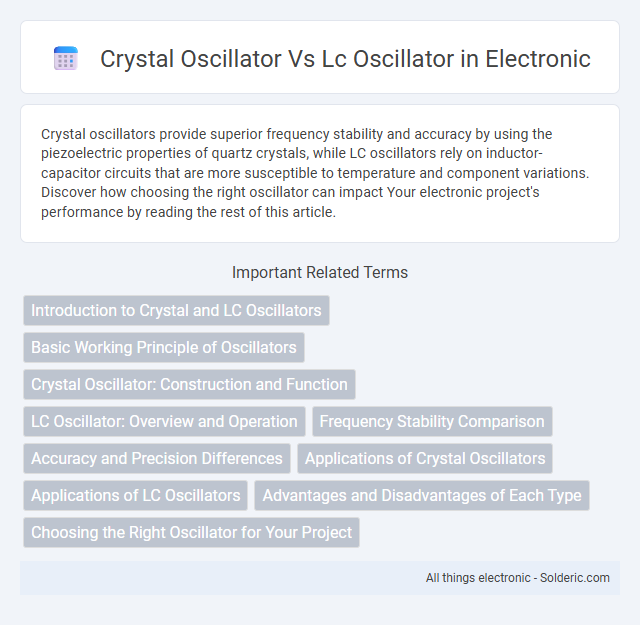Crystal oscillators provide superior frequency stability and accuracy by using the piezoelectric properties of quartz crystals, while LC oscillators rely on inductor-capacitor circuits that are more susceptible to temperature and component variations. Discover how choosing the right oscillator can impact Your electronic project's performance by reading the rest of this article.
Comparison Table
| Feature | Crystal Oscillator | LC Oscillator |
|---|---|---|
| Frequency Stability | High (+-10 ppm or better) | Moderate (+-1000 ppm or more) |
| Frequency Range | Low to Medium (kHz to ~100 MHz) | Wide (kHz to GHz) |
| Quality Factor (Q) | Very High (up to 10^6) | Moderate (100 to 1000) |
| Temperature Sensitivity | Low | High |
| Size | Small and Compact | Typically Larger (due to coils) |
| Cost | Higher | Lower |
| Application | Accurate timing, clocks, communication systems | RF circuits, tunable oscillators |
| Frequency Tuning | Limited (fixed frequency) | Easy (variable inductance or capacitance) |
Introduction to Crystal and LC Oscillators
Crystal oscillators utilize the piezoelectric properties of quartz crystals to generate highly stable and precise oscillation frequencies, making them ideal for applications requiring exceptional frequency accuracy. LC oscillators rely on an inductor-capacitor tank circuit, producing oscillations based on the resonant frequency determined by the inductance and capacitance values, commonly used in applications where frequency tuning and wide range variability are necessary. The intrinsic frequency stability of crystal oscillators surpasses that of LC oscillators due to the minimal energy loss and high Q factor of quartz crystals.
Basic Working Principle of Oscillators
Crystal oscillators rely on the piezoelectric effect of quartz crystals to generate highly stable and precise oscillations at a specific resonant frequency. LC oscillators use an inductor (L) and capacitor (C) combination to create oscillations through the energy exchange between magnetic and electric fields. The superior frequency stability of crystal oscillators makes them ideal for timekeeping and communication systems, whereas LC oscillators offer tunable frequency ranges suitable for radio frequency applications.
Crystal Oscillator: Construction and Function
Crystal oscillators use a quartz crystal as the frequency-determining element, exploiting its piezoelectric properties to generate a highly stable and precise oscillation. The crystal is cut and shaped to vibrate at a specific resonant frequency when subjected to an electric field, ensuring minimal frequency drift over time and temperature variations. Your electronic circuits benefit from this reliable frequency stability, making crystal oscillators ideal for applications requiring accurate timing signals.
LC Oscillator: Overview and Operation
LC oscillators generate stable sinusoidal signals by utilizing an inductor (L) and capacitor (C) in a resonant tank circuit, which determines the oscillation frequency based on their inductance and capacitance values. Their frequency stability is generally lower than crystal oscillators due to component tolerances and environmental changes, but they offer tunability and are commonly used in RF and audio applications. You can optimize your circuit design by choosing the appropriate LC oscillator when moderate frequency stability and adjustability are more critical than extreme precision.
Frequency Stability Comparison
Crystal oscillators offer superior frequency stability due to the piezoelectric properties of quartz, which maintain a constant resonant frequency over a wide temperature range and extended periods. LC oscillators rely on inductors and capacitors whose values can drift with temperature variations and component aging, resulting in less stable frequencies. Your applications requiring precise timing will benefit significantly from the accuracy and low frequency deviation provided by crystal oscillators compared to LC oscillators.
Accuracy and Precision Differences
Crystal oscillators provide superior accuracy and precision compared to LC oscillators due to their frequency stability, which is maintained by the quartz crystal's consistent mechanical resonance. LC oscillators are more prone to frequency drift caused by variations in temperature, supply voltage, and component tolerances, leading to less precise output signals. Your choice should favor crystal oscillators for applications requiring high-frequency stability and minimal phase noise.
Applications of Crystal Oscillators
Crystal oscillators are widely used in applications requiring precise frequency stability, such as in clocks, radios, computers, and GPS devices. Their high accuracy and low phase noise make them essential in communication systems, microcontrollers, and frequency synthesis. Crystal oscillators also play a critical role in oscilloscopes and signal generators where consistent timing signals are crucial.
Applications of LC Oscillators
LC oscillators are widely used in radio frequency (RF) applications due to their ability to generate stable signals at high frequencies. You will commonly find LC oscillators in wireless communication systems, signal generators, and RF transmitters, where tunability and frequency stability are crucial. Their use in voltage-controlled oscillators (VCOs) for phase-locked loops (PLLs) also highlights the importance of LC oscillators in frequency synthesis and modulation.
Advantages and Disadvantages of Each Type
Crystal oscillators offer superior frequency stability, low phase noise, and high precision, making them ideal for applications requiring exact timing such as clocks and communication devices. LC oscillators provide greater frequency tunability and typically lower cost but suffer from lower stability and higher phase noise due to component variations and temperature sensitivity. Your choice depends on whether you prioritize precision and stability (crystal oscillator) or flexibility and cost-effectiveness (LC oscillator).
Choosing the Right Oscillator for Your Project
Crystal oscillators offer superior frequency stability and precision, making them ideal for applications requiring accurate timing, such as communication systems and microcontroller clocks. LC oscillators provide tunable frequency ranges and are suitable for radio frequency circuits where flexibility is important, but they typically have lower stability compared to crystal oscillators. Your choice depends on whether frequency accuracy or adjustable frequency is the priority for your project's performance requirements.
crystal oscillator vs lc oscillator Infographic

 solderic.com
solderic.com